► Limited production run of 50 confirmed
► You’ll need to stump up €990,000 to secure one
► Based on the Nismo GT-R, deliveries in late 2020
You’re looking at the production-spec Nissan GT-R50 by Italdesign. After two years – and now a pandemic – the coachbuilt supercar has somehow avoided cancellations, and is now in production. Customers should expect delivery in late 2020 and early 2021.
New pictures show the GT-R50 on the Tazio Nuvolari testing circuit, as it nears the end of its dynamic testing – and it looks even better in the flesh than in the renders we’ve already seen. Customers will be able to choose a livery inspired by the history of the GT-R, with the one above reminding us only 50 will be made.

Italdesign says demand for the car has been ‘significant’ but adds that there are still a limited number of reservations left – out of 50…
‘After we had to renounce the world premiere at the Geneva motor show and, after the parrtial stop of our production activities due to COVID-19, in early May we have returned 100% operative,’ confirmed Jörg Astalosch, the Italdesign CEO.
Nissan GT-R50 production version: want one?
If you want to buy one, you can start the process by visiting www.GT-R50.nissan and then getting in touch with Italdesign to create your own bespoke version. The price is confirmed as €990,000 (around £885,000 at today’s exchange rates – although that’s undoubtedly going to change, post-Brexit).
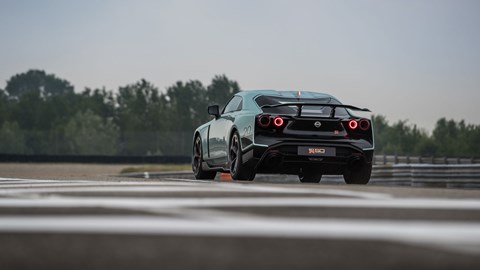
Nissan GT-R50: everything you need to know
How do you celebrate your 50th birthday? If you’re Italdesign and Nissan, you team up to create the GT-R50, a prototype that marks five decades of the GT-R model and the engineering company.
Although it’s based on a current Nissan GT-R Nismo, the GT-R50 features extreme styling, including a two-tone finish and heavily reworked front and rear ends, and it made its debut in Europe at the Goodwood Festival of Speed.
Italdesign developed, engineered and built the car, but the interior and exterior looks were created by Nissan’s design teams in Europe and America.
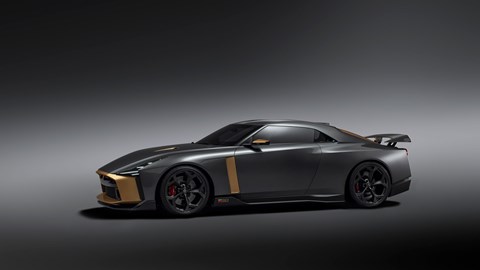
‘How often do you get to ask, “What if we created a GT-R without limits,” and then actually get to build it?’ said Alfonso Albaisa, Nissan’s senior vice president for global design.
‘This is a rare window in time when two big moments intersect: 50 years of Italdesign shaping the automotive world and 50 years of Nissan generating excitement through our iconic GT-R.’
What’s so different?
Get past the distinctive, two-tone paint-job, and the GT-R50 looks like a beefier, final-form of the current MY18 car. There’s a more pronounced power-bulge on the bonnet, while the headlights have got thinner and sharper than the production model. The side of the car reveals a roofline lowered by 54mm to promote a svelte, low-slung look – and the inlets around the side of the car also benefit from the gold and silver medley.

The rear of the car keeps the GT-R’s familiar circular tail lamps, but carves out the volume around them – giving a floating look.
When combined with a rear window that descends lower than before, it’s the back three-quarter of the GT-R50 that look most striking.
Throw in a large adjustable wing and 21-inch rims, and the GT-R50 prototype won’t be confused with the stock car any time soon.
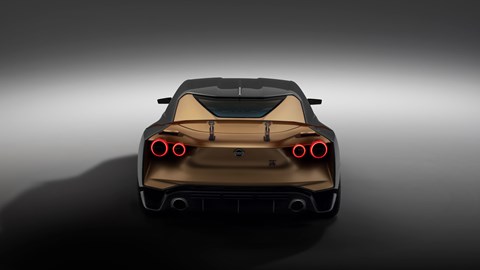
And the interior of the Italdesign GT-R?
As you’d expect, the inside of the car is a heady cocktail of Alcantara, leather and carbonfire – and there are flashes of the same gold finish you’ll find on the exterior of the car.
Do you prefer it to the regular GT-R cabin? Be sure to sound off in the comments below.
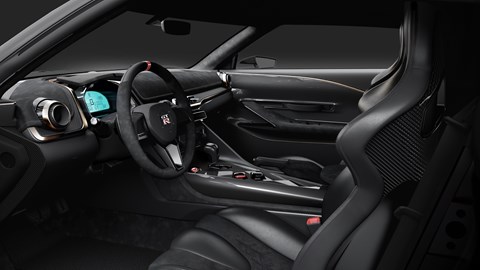
What about the the engine?
Interestingly, this isn’t just a design exercise; Nissan has tweaked the internals of the GT-R Nismo donor car, too. The hand-assembled 3.8-litre V6 VR38DETT engine now makes around 710bhp and 575lb ft of torque, thanks to twin GT3-spec turbochargers and intercoolers, and a wealth of other near racing-spec parts.
Nissan says the the crankshaft, pistons, connecting rods and bearings, piston oil jets and camshaft profiles have all been uprated, while the engine also benefits from optimised ignition timing along with new intake and exhaust systems.
Nissan has mated the upgraded engine mated to a beefier dual-clutch six-speed ‘box, with redesigned differentials and driveshafts.
And the handling?
The handling has been upgraded, too. The car now runs on a Bilstein DampTronic, adjustable damping system, while stoppers have been upped to six-piston Brembos at the front and four-piston stoppers at the rear. Michelin Pilot Super Sports finish off the handling upgrades.
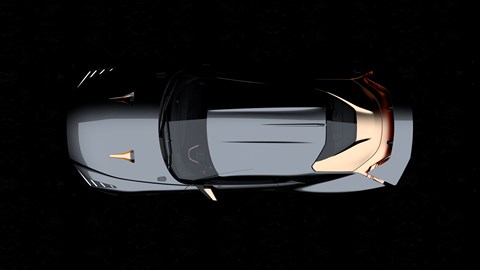
Is this a sneaky preview look at the next GT-R?
Nissan says it certainly isn’t, but you’d have to wonder given the company’s history… Over the past few years, Nissan’s GT-R concepts haven’t been too far from the production car that followed – and the GT-R50 could continue the trend.
However, Nissan’s senior vice president for global design added: ‘Although this is not the next-generation GT-R, it is an exciting celebration of two anniversaries in a provocative and creative way – wrapping one of Nissan’s best engineering platforms and Japanese design with Italian coachbuilding.’
Read all our Nissan reviews here